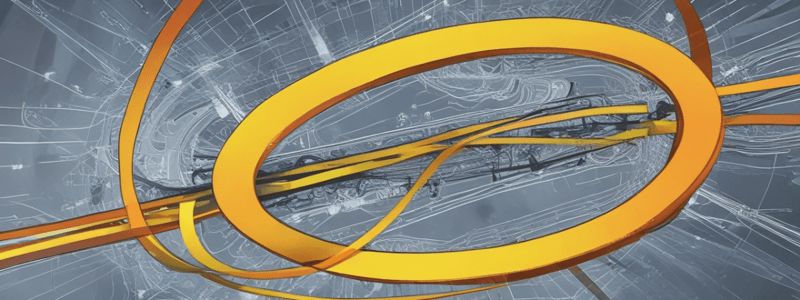Podcast
Questions and Answers
What is a force, according to the interaction between objects?
What is a force, according to the interaction between objects?
- A push or pull resulting from an interaction (correct)
- Only a pull
- A combination of three or more interactions
- Only a push
What is the direction of the force of friction?
What is the direction of the force of friction?
- In the direction of motion
- In the direction opposite to the motion (correct)
- At an angle to the motion
- Perpendicular to the motion
What is weight?
What is weight?
- The force due to acceleration
- The force due to gravity (correct)
- The force due to motion
- The force due to friction
What happens when the pair of forces are balanced?
What happens when the pair of forces are balanced?
Why don't you notice the interaction with the ground when standing in place?
Why don't you notice the interaction with the ground when standing in place?
What is the relationship between the magnitude and direction of a force?
What is the relationship between the magnitude and direction of a force?
What is the minimum number of forces in an interaction?
What is the minimum number of forces in an interaction?
What is the state of an object when there is no change in its state of motion?
What is the state of an object when there is no change in its state of motion?
What does the equation σF = 0 represent?
What does the equation σF = 0 represent?
What is the difference between static equilibrium and dynamic equilibrium?
What is the difference between static equilibrium and dynamic equilibrium?
What happens when an object is subjected to unbalanced forces?
What happens when an object is subjected to unbalanced forces?
What is the role of friction in dynamic equilibrium?
What is the role of friction in dynamic equilibrium?
What is the condition for an object to remain in mechanical equilibrium?
What is the condition for an object to remain in mechanical equilibrium?
What is an example of an object in dynamic equilibrium?
What is an example of an object in dynamic equilibrium?
What is the result of an unbalanced force on an object?
What is the result of an unbalanced force on an object?
Flashcards
Force
Force
A push or pull resulting from an interaction.
Direction of friction
Direction of friction
Opposite to the direction of motion.
Weight
Weight
The force due to gravity acting on an object.
Balanced forces
Balanced forces
Signup and view all the flashcards
Unnoticed ground interaction
Unnoticed ground interaction
Signup and view all the flashcards
Magnitude and direction of force
Magnitude and direction of force
Signup and view all the flashcards
Minimum forces for interaction
Minimum forces for interaction
Signup and view all the flashcards
Mechanical equilibrium
Mechanical equilibrium
Signup and view all the flashcards
σF = 0
σF = 0
Signup and view all the flashcards
Static equilibrium
Static equilibrium
Signup and view all the flashcards
Dynamic equilibrium
Dynamic equilibrium
Signup and view all the flashcards
Unbalanced forces
Unbalanced forces
Signup and view all the flashcards
Role of friction in dynamic equilibrium
Role of friction in dynamic equilibrium
Signup and view all the flashcards
Conditions for mechanical equilibrium
Conditions for mechanical equilibrium
Signup and view all the flashcards
Example of dynamic equilibrium
Example of dynamic equilibrium
Signup and view all the flashcards
Study Notes
Forces Come in Pairs
- A force is a push or pull resulting from an interaction between objects, and it is a vector quantity with both magnitude (how much) and direction (which way).
- All objects can exert forces, even without touching, such as friction and gravity.
- When there is an interaction, there will be at least one pair of forces in that interaction, even if the objects are not touching.
Forces Can Be Balanced
- When the pair of forces are equal in size and opposite in direction, they are balanced, and the object will maintain its state of motion.
- An object in mechanical equilibrium has no change in its state of motion, and the equation is ΣF = 0, meaning the vector sum of the forces is zero.
- Mechanical equilibrium is not limited to objects at rest, but also includes objects traveling in a straight line path.
- Examples of balanced forces include a person standing on the ground, a hanging basket, and a bowling ball rolling down a lane at a constant velocity.
Mechanical Equilibrium
- Mechanical equilibrium is a state of no change in an object's state of motion.
- It can be further divided into static equilibrium for stationary objects and dynamic equilibrium for moving objects.
- Both types of equilibrium have balanced forces, resulting in no change in the object's state of motion.
Forces Can Be Unbalanced
- Unbalanced forces are when the forces are not equal in magnitude, causing a change in the object's state of motion.
- Unbalanced forces can start or stop motion, and are needed to get an object moving or to stop it from continuing along its path.
- Examples of unbalanced forces include pushing a coffee table to get it moving, and a bowling ball hitting the pins and being disrupted from its path.
Studying That Suits You
Use AI to generate personalized quizzes and flashcards to suit your learning preferences.




